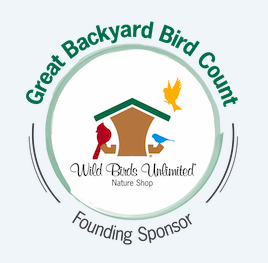Your Backyard Counts - The Great Backyard Bird Count
The Great Backyard Bird Count (GBBC) is a joint project of Cornell Lab of Ornithology and the National Audubon Society and is sponsored by Wild Birds Unlimited. It takes place over four days each February (check the link below for the specific dates for this year). Simply count the birds! Count the numbers of birds and the species variety. You can count in your backyard or any location you like for at least 15 minutes on one or more of the count days and then simply report the information online at birdcount.org.
The Great Backyard Bird Count gives you the opportunity to make a difference by participating in this annual event which links citizens with scientists in an effort to collect important data about backyard birds. This extensive information data base is analyzed by scientists to better understand important trends in bird populations, range expansions, habitat changes and shifts in migration patterns.
How To Better Identify Birds for GBBC
As a Great Backyard Bird Count (GBBC) participant, you may see birds you don’t know. To identify lesser-known birds, practice answering the following questions, looking at a bird from the top down.
1. Silhouette
Look at the bird’s overall size, shape and posture. Is it the size of something familiar like a sparrow, robin or crow? How does it sit, perch or fly?
2. Head Markings
Does the bird have a colorful or striped cap, also known as a crown? Is there a stripe above or through the eye, or does it have an eye ring or “spectacles?” Look for cheek patches or a mustache. Is there a white throat patch?
3. Body Markings
What are the overall back, breast and belly colors? What’s on the chest: a patch, spots, streaks or is it clear? Are the flanks (sides of body) clear or streaked? Is there a white or yellow rump patch?
4. Wing Markings
Are the wings a different color than the body? Are there wing bars or spots?
5. Tail Shape and Markings
Is the tail long or short compared to the body? Is it forked, squared, pointed or another shape? Are there certain colors or vertical or horizontal stripes?
We offer a variety of binoculars that will provide clear views and field guides that will help you determine a bird’s identity. With practice, you will quickly gather all the clues you need to positively identify birds.
We even have a couple Podcasts about GBBC you may want to listen to!
Episode 70: (2/9/23) Birds Bring The World Together
Episode 47: (2/10/2022) How To Participate in GBBC & Why It Matters
Smartphone Tools To Help You
Merlin Bird Id App for Smartphones
The free Merlin Bird ID app, hosted by the Cornell Lab of Ornithology, helps customers identify birds two different ways: by answering simple questions about the bird or by analyzing a photo of the bird. The app is great for beginner and expert birders and Cornell regularly updates the content on the app. Merlin will also interface with eBird to help track your count. Download from Google Play or the Apple App Store.
Tip: If you travel, we suggest you download the full US/Canada bird pack rather than multiple packs to save memory space.
eBird
eBird helps gather bird sighting data from Citizen Scientists in their own backyard or anywhere in the world and makes this data universally available to support conservation and education. It also makes birding more rewarding for the participants as they manage personal birding lists, photos and audio recordings, see real-time maps of species distribution and receive alerts about sightings. Download the eBird app from Google Play Store or the Apple App Store. eBird may also be accessed online.
Did you know that Wild Birds Unlimited is a Founding Sponsor in the GBBC?

For more tips on how to better identify birds, visit birdcount.org.


